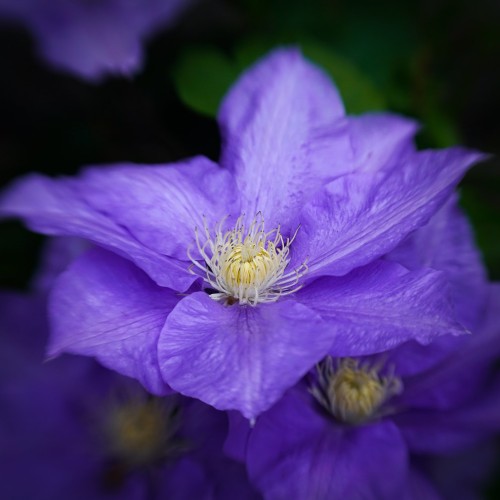
clematis
Clematis 'Edouard Desfossé'
Cycle:
Perennial
Watering:
Average
Hardiness Zone:
3 - 8
Flowers:
Flowers In Spring
Sun:
Full sun,part shade
Leaf:
Yes
Growth Rate:
Low
Maintenance:
Low
Salt Tolerant:
Yes
Care Level:
Medium
watering
Clematis 'Edouard Desfossé' should be watered deeply and consistently during the growing season. Water this plant frequently while actively growing, approximately every 7-10 days, in order to keep the soil consistently moist, but not soggy. However, be sure to check the soil before watering; if it is still moist then it does not need to be watered. During the hotter summer months, you may need to water more frequently. In the winter, water less, allowing the planting mix to dry out somewhat between waterings, but never completely.
sunlight
Clematis 'Edouard Desfossé' is an ornamental plant species that prefers full sun exposure to perform at its best. It should receive at least 6 to 8 hours of direct sunlight each day. Although it can tolerate some shade, providing it with more light will increase blooming potential and floral displays. Place it in an area that receives full sun in the morning, which is the ideal time for flowering plants to receive sunlight. For optimum growth, keep it in a southern-facing or western-facing location where it will receive the most exposure to sunlight.
pruning
Prune clematis 'Edouard Desfossé' twice a year, once in late winter and once in mid-summer. Prune late-winter-flowering varieties, including ‘Edouard Desfossé’, by removing all dead or weak stems, and then cutting back any remaining stems to just above a healthy bud. Prune mid-summer-flowering varieties in July after they have finished flowering, although you can delay pruning until late summer if there is a risk of frost. Cut the stems back to a pair of healthy buds. Avoid aggressive pruning as this will reduce the display of flowers. Instead, focus on removing dead or weak stems, and selectively thinning, being careful not to cut healthy stems too severely.
Season
Hardiness Map
FAQ
Can Clematis plants grow in pots?
Yes, Clematis plants can definitely be grown in pots. When planting a Clematis in a pot make sure to use a larger size pot with drainage holes and fill it with a mix of well-draining potting soil and compost. Ensure to keep the root area cool and the pot in a sunny location while providing regular water and fertilization. Check the plant almost daily to make sure it is not becoming too dry. Clematis can do well in a pot and with the right care and conditions, they will thrive.
Are Clematis plants self-pollinating?
No, clematis plants are not self-pollinating. Clematis plants need pollinators such as bees, butterflies, moths and other insects to transfer pollen from the male anthers to the female stigma of the flower in order to produce viable seed. Pollination must also occur within relatively close proximity of the same species in order to create viable hybrid plants.
Can Clematis plants be grown as a houseplant?
Yes, Clematis plants can be grown as a houseplant. It is best to grow them in a pot with full sun and a soil that is rich in organic material and retains moisture. When potting the plant, place a stake or trellis next to the pot so that the vine can climb when it begins to grow. Be sure to water your Clematis plant regularly to keep it healthy and growing. Additionally, keep an eye out for pests and treat with natural insecticides as necessary.
Could Clematis plants survive in a colder climate?
Yes, Clematis plants can survive in colder climates with proper preparation. If planted in the fall, proper mulching should be done to protect the roots from cold temperatures. If planted in the spring, they should be watered frequently to help them adjust to the cooler temperatures more quickly. If temperatures drop below -20°C ( -4°F), additional measures may need to be taken such as the application of protective wraps and thermal insulation. Additionally, plants in exposed areas should be protected from the wind to prevent excessive dehydration. With the right measures in place, Clematis plants can easily survive in colder climates.
Could Clematis plants be grown in a greenhouse?
Yes, clematis plants can be grown in a greenhouse. Due to their vine-like growth habit and tropical native origins, clematis plants thrive in the moist and warm environment of a greenhouse. Clematis are generally grown from cuttings or from dividing existing plants, and benefit from regular pruning and fertilizing. They will also enjoy the indirect light of a greenhouse and the protection from strong winds and temperatures that the humidity and contained environment provides.
